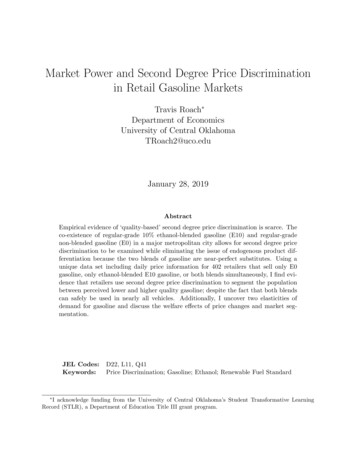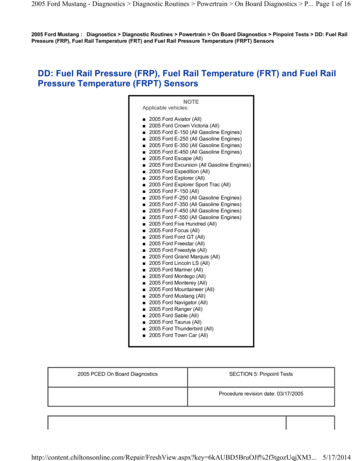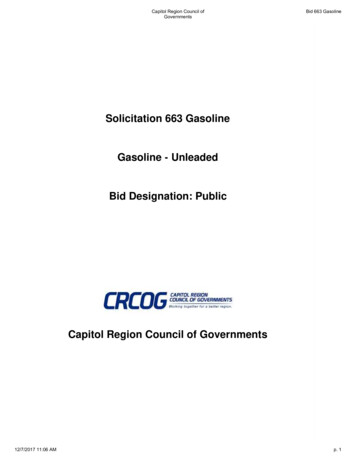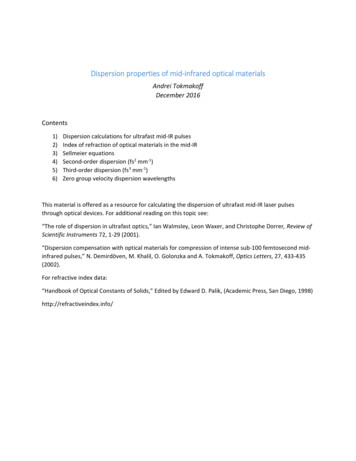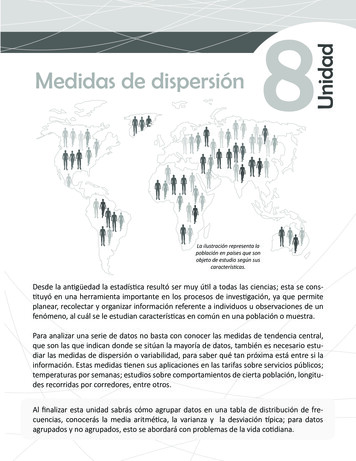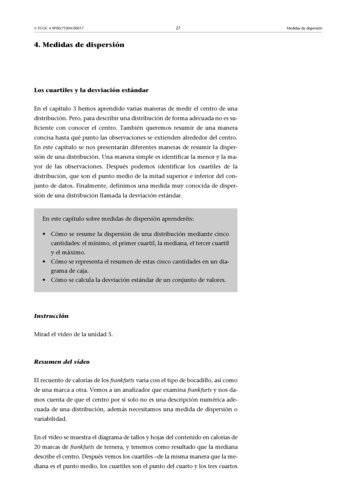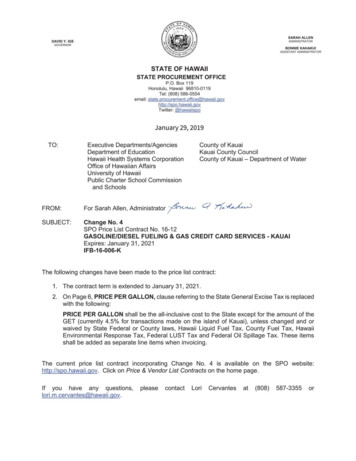
Transcription
Understanding Gasoline Price DispersionDemet Yilmazkudayy and Hakan YilmazkudayzMay 26, 2016AbstractThis paper models and estimates the gasoline price dispersion across time and spaceby using a unique data set at the gas-station level within the U.S. Nationwide e ects(measured by time xed e ects or crude oil prices) explain up to about 51% of the gasoline price dispersion across stations. Re nery-speci c costs, which have been ignoredin the literature due to using local data sets within the U.S., contribute up to another33% to the price dispersion. While state taxes explain about 12% of the price dispersion, spatial factors such as local agglomeration externalities, land prices, distributioncosts of gasoline explain up to about 4%. The contribution of brand-speci c factors isrelatively minor.JEL Classi cation: L11, L81, R32, R41,Key Words: Gasoline Prices; Gas-Station Level Analysis; Nighttime Lights; LandPrices, the United StatesThe authors also would like to Shu Deng and James Bailey for excellent research assistance, ZillowResearch for the housing price data, and seminar participants at various places for their feedback and suggestions. The usual disclaimer applies.yDepartment of Economics, Florida International University, Miami, FL 33199, USA;e-mail: dyilmazk@ u.eduzDepartment of Economics, Florida International University, Miami, FL 33199, USA;e-mail: hyilmazk@ u.edu
1. IntroductionRetail prices of gasoline are considerably di erent across gas stations within the U.S. whereconsumer expenditure share of gasoline is about 5%. Since such price di erences may bere‡ecting the frictions in the economy, understanding the reasons behind them is the key toan optimal policy that would improve the level and distribution of individual welfare. Forexample, consider a typical day in 2010-2011 when the retail-level gasoline price di erencebetween any two gas stations within the U.S. was as high as 2.25 (followed by 2.19) pergallon of regular gas.1 If you think that this price dispersion was due to di erences in statetaxes per gallon, which ranged between 46.6 cents (for California) and 8 cents (for Alaska)in 2010 and between 49.6 cents (for Connecticut) and 8 cents (in Alaska) in 2011, you areonly partially right, because, for a typical day of the very same sample period, the pricedi erence between any two gas stations within any given state/district of the U.S. was ashigh as 1.57 (for Washington D.C. on October 15th, 2010) followed by 0.99 (for Iowa forOctober 10th, 2010).2 Therefore, gasoline price di erences not only exist across states butalso within states; accordingly, a detailed spatial analysis (rather than a state-level analysis)is required to understand the details behind gasoline price dispersion.We pursue such an investigation by testing the implications of a spatial model (of gasoline1The gasoline price di erences of both 2.25 and 2.19 were between Washington D.C. and Michigan onOctober 23rd, 2010 and December 16th, 2010, respectively2The gasoline price dispersion was not due to outliers, either; because, for a typical day, the median pricedi erence between any two gas stations within any given state/district of the U.S. was as high as 0.60 (forHawaii) followed by 0.44 (for Washington D.C.) and by 0.41 (for Wyoming). Table 1 depicts the completedescriptive statistics.
consumption, production, and distribution) with a comprehensive gas-station level gasolineretail price data (with about half a million price observations) obtained from all around theU.S.3 In the model, consumer-producers get utility out of their consumption of goods as wellas gasoline which is required for transportation purposes. The necessity for transportationalso depends on the distribution of economic activity around the individual who is assigned aspeci c spatial location. Spatially distributed gas stations maximize their pro ts based on thegasoline demand of consumer-producers who are involved in economic activity around the gasstation. Gas stations also take into account the cost of gasoline (charged by nearest re ners)and other spatial factors (such as the size and the distribution of economic activity aroundthe gas station, the distance of the gas station to the re nery, number of other gas stations inthe vicinity). Optimization implies that the equilibrium price of gasoline at a particular gasstation depends on spatial economic factors, the cost of gasoline at the re nery, legislativefactors (such as state-level taxes), local competition, and brand-speci c costs/bene ts. Wetest the implications of this model on the gasoline price di erence across gas stations usinga unique data set that is introduced next.The daily gasoline price data set covering the period between September 10th, 2010and January 31st, 2011 involves brand information of gas stations as well as their locationinformation at the exact address level. Combining this data set with the exact (address-level)3Studies such as Chouinard and Perlo (2007) have used the state-level price observations and shown that(i) the gasoline price dispersion within the U.S. is due to changes in the price of crude oil; and (ii) acrossstate variation in prices can be attributed to demand variation, as well as di erences in taxes, environmentalregulations and market power. In addition to such studies, this paper attempts to explain the spatial gasolineprice di erences within states.2
location information of oil re neries, state-level taxes, crude oil prices, land prices (at thezip-code level), and local agglomeration externalities of spatial gasoline demand (namely,the distribution of nighttime lights data across space), we decompose the e ects of crude oilprices, re nery costs, distribution costs, brand-speci c costs, state taxes, land prices, andlocal agglomeration externalities (i.e., spatial demand and number of competitors) througha spatial analysis that models and estimates the transportation needs of individuals anddistribution of gasoline from re neries to gas stations. While the crude oil prices (or anyother time-varying e ect that is common across gas stations) are considered to capture timevarying e ects that are common across all gas stations within the U.S., other cross-sectionalvariables are considered to capture the e ects due to spatial factors.The empirical results show that one percent of an increase in local agglomeration externalities reduces gasoline prices up to 1:92%, while one percent of an increase in the numberof competitors can reduce gasoline prices as much as 0:19%. Distribution costs of gasolinefrom the nearest re ner to the gas station have positive and signi cant e ects, where onepercent of an increase in distribution costs leads to an increase up to about 0.41% in gasolineprices. It is also shown that one percent of an increase in land prices leads to an increaseup to about 0:79% in gasoline prices. These results are robust to the consideration of brand xed e ects, time xed e ects, re nery xed e ects, and alternative spatial measures (for thematching between consumer-producers and gas stations). It is also shown that the proposedmodel explains the data well; the R-squared values for alternative spatial measures are allabout 0.90.We further investigate the contribution of each model component in explaining the gasoline price di erences across gas stations. The corresponding variance decomposition of gaso3
line prices across time and space suggests that the highest contribution is by time xed e ects(or crude oil prices) capturing up to 51% (or 39%) of the price dispersion (i.e., nationwidee ects are almost half of the overall e ects), followed by re nery-speci c costs capturing upto 33% of the price dispersion, state taxes capturing up to 12% of price dispersion, and spatialfactors (such as local agglomeration externalities, land prices, distribution costs of gasoline)capturing up to 4% of price dispersion. The contribution of brand-speci c costs is relativelyminor. Within this picture, as discussed in details in the next section, the main contributionto the existing literature has been to show that re nery-speci c costs explain a big part ofthe price dispersion across gas stations, which has been mostly ignored in the literature dueto using local data sets covering either a couple of cities or states within the U.S.2. Literature ReviewThis paper is connected to the empirical literature analyzing the determinants of gasolineprice dispersion at the gas station level. The literature has focused on price control variablessuch as (i) local demographics or station location (LDSL), (ii) brand or contractual arrangements (BCA), (iii) station density or local concentration (SDLC), and (iv) physical stationcharacteristics (PSC).4In the literature, Shepard (1993) has used cross-sectional gasoline price data collected overa twelve week period in the rst quarter of 1987 from over 1,100 gas stations from EasternMassachusetts. Shepard has shown that prices across stations vary with the contractual formbetween re ners and stations, with the number, proximity and characteristics of competingretailers, and with station characteristics such as selling non-gasoline products or services; but4See Eckert (2013) for a survey of empirical studies of gasoline retailing.4
prices do not vary with market conditions such as tra c volume. Ning and Haining (2003)have used gasoline price data collected over eight biweekly period in mostly the rst quarter of1995 from 113 gas stations, together with price data collected over six weekly period in mostlythe rst quarter of 1997 from 96 gas stations, from She eld, England. They have shown thatspatial competition and being attached to a supermarket are statistically signi cant, but thenumber of cars around the gas station and/or percentage of higher income households inthe neighborhood of a station are not statistically signi cant. Van Meerbeeck (2003) hasused gasoline price data covering 477 gas stations in Belgium on a daily basis between 1998and 2001. This data set includes only two brands of gasoline (Shell and TotalFina). VanMeerbeeck has observed that prices vary with stations located along a highway always chargethe maximum price determined by an agreement between the oil industry and the Belgiangovernment, and prices are below the maximum price in markets with su cient competitionand that the number of local competitors does not have a large impact on retail gasolineprices. Barron et al. (2004) have used cross-sectional gasoline price data covering 3,197gas stations in four metropolitan areas (Phoenix, AZ, Tuscon, AZ San Diego, CA, and SanFrancisco, CA) for only one day in 1997 (where that one day di ers across metropolitanareas). They have found that an increase in station density consistently decreases both pricelevels and price dispersion across four geographical areas. They have also found that pricevary with brand identi ers, with a variable indicating whether the primary image of thestation is a convenience store or a repair station, with a variable indicating whether fullservice gasoline is sold at the station, and with a variable re‡ecting the number of fuelingpositions. Eckert and West (2004) have used daily gasoline price data covering several gasstations over a period of eight months in 2000 from Vancouver and Ottawa metropolitan5
areas in Canada. They have shown that brand identities, concentration of gas stations,and the type of ownership are signi cant in explaining price di erences across gas stations.Clemenz and Gugler (2006) have used daily gasoline price data collected over a ve monthperiod in 2000 and 2001 covering 1,603 gas stations from in Austria. They have found thatprices vary with station density, but ownership concentration is not statistically signi cant.Pennerstorfer (2009) has used cross-sectional price data covering 400 gas stations in LowerAustria for September 2003. Pennerstorfer has shown that prices vary with branded versusunbranded gas stations. Chandra and Tapatta (2011) have used daily gas-station level datacovering the states of California, Florida, Texas, and New Jersey covering the 18 monthsperiod between January 2006 to May 2007. They have shown that price dispersion increaseswith the number of rms in the market and consumer search costs.Compared to the literature mentioned so far, this paper uses gasoline price data of anunbalanced daily panel over 144 days from 38,245 gas stations from all around the U.S.In addition to the literature, we have found that re ner xed e ects are econometricallysigni cant in explaining gasoline prices, which is the key in understanding the spatial gasolineprice dispersion within the U.S. and has been ignored by the existing literature focusing onlocal data sets. In particular, having a local-level analysis (as in the existing literature)would suppress the main determinants of gasoline prices such as re nery e ects, becausemany gas stations within the same location would already face similar local input costsdue to purchasing gasoline from the same (or closeby) re ners. In contrast, employing anationwide spatial analysis in this paper has allowed for comparisons across locations, whichhave resulted in depicting the high contribution of re nery xed e ects (among others, as6
discussed, above) to the spatial gasoline-price dispersion.5 Furthermore, considering gasolineprice dispersion at the gas-station level across time and space within the U.S., we also showthat time xed e ects (capturing crude oil price changes as well as other time-varying costscommon across gas stations) contribute most, followed in descending order of magnitudeby LDSL (i.e., the sum of the e ects of re nery costs due to the station location, spatialdemand, and land prices), legislative e ects (i.e., state-level taxes), SDLC (i.e., number ofcompetitors) and BCA (i.e., brand identities).3. The Economic EnvironmentWe would like to model the details of (i) the retail chain in the U.S. gasoline market (to thedegree that our data allow us), (ii) price-setting behavior of gas stations, and (iii) the spatialdistribution of economic activity among individuals. Regarding the retail chain in the U.S.gasoline market, at least 90% of the gasoline sold at retail-level gas stations is produced byre ning crude oil (because up to 10% of the retail-level gasoline may be ethanol in the U.S.).The gasoline produced at the re nery is then either directly transported to gas stations bytruck or to local distribution/bulk terminals by pipeline, barge or rail. In the latter case,local distribution terminals add some additives such as ethanol or brand-speci c ingredients(e.g., Chevron including Techron into its gasoline) and sell the nal version of gasoline to5To further understand the e ects of re ner xed e ects on the spatial distribution of gasoline prices, onemay also consider the re nery-related price jumps in California in October 2012, where gasoline prices wereas high as 5 at the gas-station level, while the nationwide average was only about 3.82. Please ia/ formore details.7
retail-level gas stations where transportation is mostly achieved by trucks. Studies such asBorenstein et al. (1997) and Kleit (2005) have depicted more details about the gasolineproduction and distribution within the U.S. Within this picture, since (i) our primary dataset is for retail gasoline prices at the gas station level, (ii) our secondary data set is forthe location of re neries, and (iii) we do not have any data on distribution terminals, weonly model the production of gasoline at the re neries and the distribution of gasoline fromre neries to the gas stations; i.e., we skip modeling local distribution terminals and includethe possible injection of additives in the production function of gas stations. Accordingly, asin Chouinard and Perlo (2007) or Doyle and Samphantharak (2008), we assume that eachgas station purchases gasoline from the nearest re ner.We model the gasoline demand of individuals/producers in a spatial context. A typicalindividual s produces a particular amount of good s to sell; this is the only source of incomefor individual s. To match individuals with space, we also denote the location/space thatis used for the economic activity of the individual by s. Individual s consumes gasolineand other goods purchased from other individuals around her. The transportation needs ofindividual s also depends on the distribution of economic activity around her; e.g., a dispersedcity like Miami, FL may require more transportation than a compact city like San Francisco,CA.Spatially distributed gas stations maximize their pro ts based on the gasoline demandof individuals, the cost of gasoline (charged by nearest re ners), and other spatial factors.Optimization implies that the price of gasoline at a particular gas station depends on spatialeconomic factors (such as the size and the distribution of economic activity around the gasstation, the distance of the gas station to the re nery, number of other gas stations in the8
vicinity), the cost of gasoline at the re nery (re‡ecting the changes in oil prices), legislativefactors (such as state-level taxes), local competition, and brand-speci c costs/bene ts.Although the model is mostly static in technical terms, the time dimension comes intopicture through state-level taxes, land prices, and time-varying crude oil prices. To keep thenotation simple, we will skip the time dimension until the end of this section.3.1. IndividualsThe unique individual s at location s 2 Sslat ; Sslon , with Sslat and Sslon representing thelatitude and longitude intervals, has the utility given by:Uslog Cs(3.1)!Yswhere Cs is an aggregate index of consumption and !Ys is the disutility due to producing Ysamount of good s. Consumption of goods is combined with usage of gasoline that is assumedto depend on the spatial distribution of economic activity around individual s. Accordingly,Cs is de ned by the following constant elasticity of substitution (CES) aggregator:Cs (Qs )1 (Ds )1(Gs )11where Qs is an aggregate index of goods, Gs is the consumption of gasoline, and Ds represents the spatial distribution of economic activity around individual/location s. Therefore,individual s has a higher preference toward gasoline (i.e., a higher value of Ds ) if she is livingin a neighborhood with a more dispersed economic activity.66This modeling approach considers distance-related costs in an indirect way through the spatial distri-bution of economic activity. An alternative approach may be to consider the distance-related disutility ofindividuals from going to any gas station in a direct way. However, there is no empirical evidence in the9
Individual s sells her product Ys to other individuals at a price ofss,which is furtherused to maximize utility subject to the following budget constraint:Cs PsYsss(3.2)where Ps (to be further de ned, below) is the price index for Cs . Utility maximization resultsin the following expression for the amount of good s produced:7Ys 1!(3.3)The optimal allocation of expenditure yields the following demand functions for Qs and Gs :Qs s(3.4)CsPsandRsPsG s Dswheretoss(3.5)Csand Rs are the prices of Qs and Gs , respectively. It is implied that Ps is connectedand Rs as follows:Ps( s )11 Ds (Rs )11(3.6)Individual s can satisfy her aggregate gasoline demand of Gs from di erent gas stationsaround her through another CES aggregator:Gs X(Ns )g2Ss1(Ggs )1!1(3.7)literature for such a consideration; moreover, we do not have any data (that match individuals with gasstations) that can be used to test the implications in such a case. In sum, we believe that we have the bestavailable modeling approach given the data and empirical evidence in the literature.7This is also the expression one can get with a modeling strategy which endows each individual withunit of product.101!
where g 2 Ss represents the set of gas stations around individual s, Ggs is the gasoline demandof individual s at gas station g (which is around individual/location s), and Ns is the numberof gas stations around individual/location s. The optimal allocation of gasoline expenditureyields the following demand function of individual s at gas station g:Ggs 1NsRgRsGs(3.8)Ds Xs (Rg )Nswhere Xs (Ps ) Cs is a measure of the size/scale of economic activity of individual s, andRg is the retail price of gasoline (per gallon) at gas station g that satis es:RsX (Rg )1Nsg2Ss!11(3.9)3.2. Gas StationsSince we do not model local distribution terminals, we include the possible injection ofadditives (e.g., Chevron injecting Techron into its gasoline) in the production function of gasstations. In particular, gas station g of brand b located at location g produces Y g gallons ofgas according to:Yg (K g ) (B g ) (H g )1Agwhere K g is the amount of gasoline purchased from the nearest re nery, B g is the brandspeci c additives included into the gasoline, H g is the land/area, and Ag is the productivitywhich is assumed to be subject to local agglomeration/Marshallian externalities:Ag fgG(111fgN1)1
fg represents the size and spatial distribution of economic activity around gas stationwhere Gfg is the number of gas stations around gas station g, andg, Nand (1) are the parametersgoverning the strength of production externalities.8 The gas station chooses K g taking theprice set by the nearest re nery as given. The cost minimization results in the followingmarginal cost of production:gM (Wr (1 gr ))fgG(bg ) (hg )1fgN(3.10)1where Wr is the price of gasoline charged by the nearest re nery r,grrepresents transportcost of gasoline from the nearest re nery r to gas station g, bg is the price of brand-speci cingredients/additives, and hg is the price of land. On top of the marginal cost of production,gas station g also pays (net) gasoline taxes of tg . Considering such additional costs, gasstation g sets its price by maximizing its pro t of:g (RgM g (1 tg )) Y gsubject to the demand for gasoline at gas station g.We need to match individuals with gas stations to calculate the demand for gasoline atgas station g. Accordingly, we will model individuals purchasing gasoline from gas stationsaround them. Although "around them" is an uncertain concept, we will de ne it in detailand provide alternative measures for it in the Appendix covering the details of the data. Fornow, we will simply consider that any individual s around gas station g will have a demandfor gasoline at gas station g given by Equation 3.8. The number of individuals, however,will change with respect to the spatial measure of location considered. As a result, the total8For simplicity, the denominator has been selected to get rid of the constant terms in the calculation ofmarginal cost, below.12
demand is given by:XGgs (Rg )s2SgX Ds XsNss2Sgwhere s 2 Sg represents the set of individuals around gas station g. Substituting this expression into the market clearing condition, we have Y g Ps2SgGgs , which implies that theoptimal retail price of gasoline for gas station g can be obtained as:Rg M g (1 tg )where M g is already given in Equation 3.10, and (3.11)1represents the gross markup.3.3. Re nersRe ner r produces Yr units of gasoline according to a linear production function:Yr O rwhere Or is the amount of crude oil used as an input. The re nery chooses Or taking itsprice as given. The cost minimization results in the following marginal cost of production:Mr W o (1 or ) (1where W o is the price of crude oil at the oil eld,orT)(3.12)represents net transport costs of crudeoil from the oil eld to the re nery, and T represents subsidies/transfers received. Since wedo not have any price data for re ners, rather than complicating the model with unnecessarydetails, we simply assume that the re ner sets its price equal to its marginal cost:9Wr W o (1 9or ) (1T)(3.13)In the empirical analysis below, we will use re ner xed e ects to capture any other detail (that iscommon through time) of the gasoline prices charged by re ners that have not been modeled here.13
As in the case of gas stations, although we accept the location of re ners given in ourempirical investigation, we assume that the location-selection problem of re ners has alreadybeen achieved in an upper-level optimization (that has resulted in a zero-pro t conditionunder the simple assumption of free entry).3.4. Closing the ModelFor simplicity, we close the model by assuming that (i) gas stations and land are ownedby re ners with equal shares among them (although they are managed independently sothat they have their own optimization problems), and (ii) tax revenues are used to subsidizere ners. Accordingly, gas station pro ts, tax revenues, and land income are transferred toall re ners through T in Equation 3.12, where T , which is common across re ners, is chosenin such a way that the total amount of subsidies/transfers is equal to the total amount ofgas station pro ts, tax revenues, and land income for each time period.3.5. Time DimensionThe time dimension of the model comes from the price of crude oil W o (which is an input forthe re ner), taxes tg (which can be di erent between legislative years), land prices hg (subjectto changes due to local markets that we do not model), gas station markups(determinedon a daily basis, since marginal costs may change every day), and transfers to re ners T(capturing time-varying gas station pro ts, tax revenues, and land income). Accordingly,using Equations 3.10 and 3.13, the gasoline price expression for gas station g (i.e., Equation14
3.11) can be rewritten as follows, this time with the time dimension:Rtg (Wto (1 or ) (1Tt ) (1 gr ))fgG(bg ) (hgt )1fgN(1 tgt )t1(3.14)fg and Nfg are assumedThis is the expression of which log version we estimate below, where Gto be constant over time.4. Empirical AnalysisThis section depicts the estimation methodology, details of the variance decomposition analysis, and empirical results. We estimate the log version of Equation 3.14 by matching thedetails of the model with the data as detailed in the Appendix through Equations 7.1, 7.4,7.5, and 7.6.4.1. Estimation MethodologyUsing the data de nitions in the Appendix, the log gasoline prices can be written as follows:log Rtg log (Wto (1{zTt )t)Time Fixed E ects }log ( g ){z }S.D. of Nighttime Lights (1 log (1 {zor)}Re nery Fixed E ects(1 log (dgr ){z }Distance to Re neryfg log (bg )) log N {z }{z} Brand FixedE ects# of Nearby Stations) log (hgt2m ) log 1 tg;state;multiplicativet2y{z} {z}Land PricesState Taxesederal;multiplicative log 1 tg;f "gtt2y {z} {z} ResidualsFederal Taxes15(4.1)
which can be estimated using time xed e ects to measure the time-varying costs of log (Wto (1re nery xed e ects to measure log transport costs of crude oil from the oil eld to the re nerylog (1 or ),log distance to the re nery log (dgr ) to measure transportation costs of gasolinefrom the re nery to the gas station, log standard deviation of nighttime lights log ( g ) to measure the size and spatial distribution of economic activity around gas station g, log numberfgof gas stations log Naround gas station g, brand xed e ects to measure brand-speci ccosts log (bg ), time-varying log Zillow Home Value Index at the zip-code level to measureland prices log (hgt2m ), time-varying state taxes calculated by Equation 7.5 for di erent years(e.g., 2010 versus 2011) to measure log 1 tstate;multiplicative, and federal taxes calculatedtby Equation 7.6 to measure 1 tft ederal;multiplicative ; the unexplained part (i.e., residuals of"gt ) are assumed to represent the measurement errors. Since state and federal taxes have acoe cient of one in front of them, we use restricted least squares for the estimation.104.2. Variance Decomposition AnalysisAlthough the regression analysis depicts how the gasoline prices change with right hand side(RHS) variables, it cannot explain the contribution of each RHS variable on the variance ofgasoline prices across gas stations, which is a natural measure of gasoline price dispersion.Note that the variance decomposition analysis also depicts the percentage of total sum ofsquares explained by each RHS variable; i.e., it decomposes the contribution of each RHSvariable on the R-squared measure. Accordingly, using the estimated parameters and the10It is important to emphasize that we cannot identify the individual parameters of ,identifyor , while we canand . Nevertheless, their identi cation is not necessary for the variance decomposition analysis,below, where all we need is the overall tted value of each component on the right hand side of Equation 4.1.16Tt )),
tted values coming from the estimation of Equation 4.1, we will conduct a variance decomposition analysis where we will further investigate the role of each explanatory variable onthe variance of gasoline prices across gas stations as follows:gvar log Rs;t cov ( log (Wto (1 Tt ){z gt ) ; log Rt )}Time Fixed E ects cov ( log (dgr ) ; log Rtg ){z}Distance to Re nerycov (1 cov ((1 cov ( cov ( log (1 {zgor ) ; log Rt )Re nery Fixed E ects}log ( g ) ; log Rtg ){z}S.D. of Nighttime Lightsfg ; log Rtg cov ( log (bg ) ; log Rtg )) log N{z}{z} Brand FixedE ects# of Nearby Stations) log (hgt2m ) ; log Rtg ){z}Zillow Home Value Index cov log 1 tg;state;multiplicative; log Rtgt2y {z}State Taxesederal;multiplicative cov log 1 tg;f; log Rtg cov ("gt ; log Rtg )t2y{z} {z} ResidualsFederal Taxeswhere var is the operator of variance and cov is the operator of covariance.4.3. Empirical ResultsThe estimation results of Equation 4.1 are given in Table 2 where di erent spatial measures (as introduced in the Data Appendix) have been considered. In all regressions, brand,re nery, and time xed e ects have been included. As is evid
and that the number of local competitors does not have a large impact on retail gasoline prices. Barron et al. (2004) have used cross-sectional gasoline price data covering 3,197 gas stations in four metropolitan areas (Phoenix, AZ, Tuscon, AZ San Diego, CA, and San

